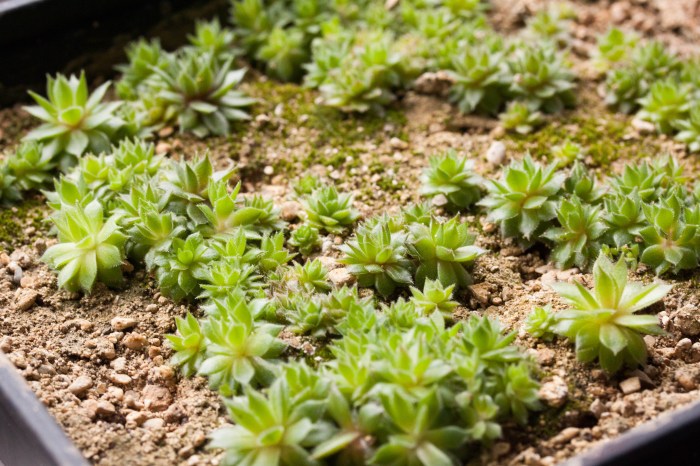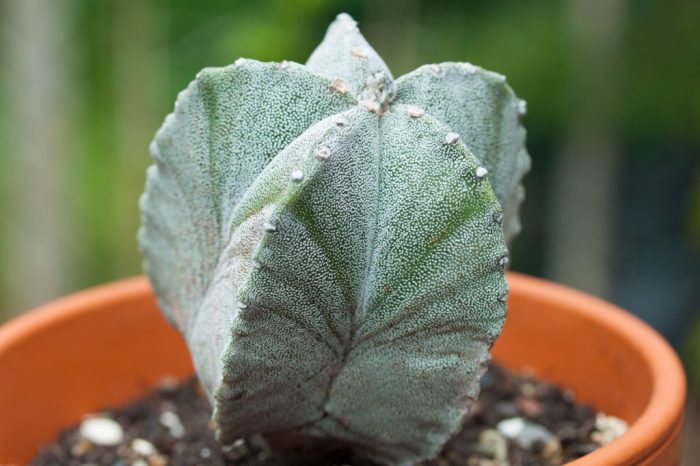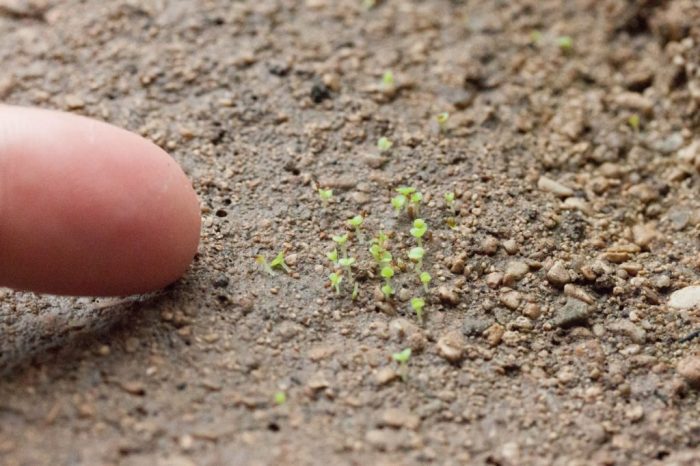How to Grow Succulent Plants from Seeds
Seed Starting Basics
How to grow succulent plants from seeds – Successfully germinating succulent seeds requires understanding the specific environmental conditions these tiny plants need to thrive. Proper preparation of the seeds themselves also plays a crucial role in their germination success rate.
Ideal Conditions for Succulent Seed Germination
Succulent seeds germinate best under specific conditions. Warmth, sufficient light, and controlled humidity are key factors. Ideal temperatures typically range from 70-75°F (21-24°C). While direct sunlight is generally avoided to prevent overheating and drying, bright, indirect light is essential for healthy seedling development. Maintaining a consistently moist but not soggy environment is crucial; a humidity dome or covering can help achieve this.
Preparing Succulent Seeds for Planting
Pre-soaking seeds can improve germination rates. This process involves submerging the seeds in lukewarm water for 12-24 hours before sowing. This helps to soften the seed coat and encourage faster sprouting. However, some seeds might not require pre-soaking and may even be negatively impacted by it. Always refer to specific instructions for your chosen succulent variety.
Sowing Succulent Seeds
Sowing succulent seeds involves carefully placing them in a suitable medium. This process can be carried out in seed trays or individual small pots, depending on the number of seeds and the desired level of control.
| Seed Starting Mix | Description | Pros | Cons |
|---|---|---|---|
| Standard Seed Starting Mix | Commercially available mix, often peat-based. | Readily available, relatively inexpensive. | Can retain too much moisture for succulents. |
| Cactus and Succulent Mix | Specifically formulated for cacti and succulents, with added perlite or pumice. | Excellent drainage, promotes healthy root development. | May be more expensive than standard mixes. |
| DIY Mix (e.g., perlite, vermiculite, peat moss) | Customizable blend for optimal drainage and aeration. | Allows for precise control over mix components. | Requires more effort and sourcing of ingredients. |
Choosing the Right Soil and Containers
The success of your succulent seedlings hinges on providing them with well-draining soil and appropriate containers to prevent root rot, a common issue for succulents. The choice of container material also impacts moisture retention and temperature regulation.
Well-Draining Soil for Succulents
Succulents are prone to root rot in overly moist conditions. A well-draining soil mix is crucial for preventing this. A good mix should allow for excellent aeration and drainage while still retaining some moisture. Here are a couple of recipes:
Recipe 1: 1 part potting soil, 1 part perlite, 1 part coarse sand
Recipe 2: 2 parts cactus and succulent potting mix, 1 part perlite
Container Selection for Succulent Seed Starting
Various containers are suitable for starting succulent seeds, each with its advantages and disadvantages.
| Container Type | Description |
|---|---|
| Seed Trays | Offer space for multiple seedlings, efficient use of space. |
| Small Pots (2-3 inch) | Provide individual space for each seedling, easier transplanting. |
| Propagation Domes | Maintain humidity, ideal for delicate seedlings. |
Container Material Comparison
| Material | Advantages | Disadvantages |
|---|---|---|
| Plastic | Lightweight, inexpensive, retains moisture. | Can overheat in direct sunlight. |
| Terracotta | Porous, allows for good air circulation, prevents overheating. | Can dry out quickly, more expensive. |
Watering and Light Requirements

Source: thegreedyvegan.com
Maintaining the correct balance of watering and light exposure is crucial for the healthy development of succulent seedlings. Overwatering or underwatering can have detrimental effects, leading to either root rot or stunted growth.
Watering Schedule for Succulent Seedlings
Water seedlings gently but thoroughly when the top inch of the soil feels dry. Avoid overwatering, which can lead to damping-off (fungal disease). During germination, keep the soil consistently moist but not soggy. As seedlings grow, gradually reduce watering frequency.
Light Exposure for Succulent Seedlings
Succulent seedlings need bright, indirect light to thrive. Direct sunlight can scorch their delicate leaves. The specific light requirements vary depending on the succulent species. For example, Echeveria seedlings may tolerate more direct sun than Sedum seedlings.
Signs of Overwatering and Underwatering
Overwatering manifests as wilting, yellowing, and mushy stems or leaves. Underwatering results in shriveled leaves and stunted growth. Adjust watering accordingly based on these signs.
Protecting Seedlings from Pests and Diseases
Succulent seedlings, being small and delicate, are vulnerable to various pests and diseases. Preventative measures and early intervention are crucial to ensure their survival and healthy growth.
Common Pests and Diseases
Common pests include aphids, mealybugs, and spider mites. Diseases such as damping-off (a fungal disease affecting seedlings) and root rot can also affect young succulents.
Preventative Measures
Preventative measures include using sterile soil and containers, ensuring good air circulation, and avoiding overcrowding. Regularly inspect seedlings for any signs of pests or diseases.
Natural and Organic Pest and Disease Control

Source: thegreedyvegan.com
Natural methods include using insecticidal soap or neem oil for pest control. For fungal diseases, ensuring good air circulation and avoiding overwatering are crucial. In severe cases, a fungicide might be necessary.
Growing succulents from seed requires patience and the right conditions, similar to many other plants. The process involves sowing tiny seeds in well-draining soil and providing consistent, gentle moisture. Understanding seed starting techniques is key, and the principles are quite similar to those for other flowering plants, such as calendula; for detailed instructions on planting calendula seeds, check out this helpful guide: how to plant calendula seeds.
Once you’ve mastered the basics, you can easily apply them to growing a wide variety of succulent species from seed.
Transplanting and Aftercare

Source: thegreedyvegan.com
Once succulent seedlings have developed a few true leaves, they’re ready for transplanting into individual pots. This provides each plant with ample space to grow and develop a robust root system. Proper aftercare is essential to ensure their continued health and vigor.
Transplanting Succulent Seedlings
Gently remove seedlings from their seed trays or pots, ensuring not to damage their roots. Plant them in slightly larger pots filled with well-draining succulent potting mix. Water lightly after transplanting.
Ideal Soil and Pot Size for Transplanting
Use a well-draining succulent potting mix and pots that are only slightly larger than the root ball. Avoid overly large pots, as this can lead to overwatering issues.
Aftercare for Transplanted Seedlings
Provide bright, indirect light and water sparingly, allowing the soil to dry out between waterings. Fertilize lightly during the growing season using a balanced, diluted succulent fertilizer.
| Succulent Species | Growth Rate | Ideal Transplanting Timeline |
|---|---|---|
| Echeveria | Moderate | 3-4 months after germination |
| Sedum | Fast | 2-3 months after germination |
| Sempervivum | Moderate | 3-4 months after germination |
Illustrative Examples of Succulent Seed Starting: How To Grow Succulent Plants From Seeds
Different succulent species exhibit unique seed characteristics and have varying growing requirements. Understanding these nuances is crucial for successful propagation.
Echeveria Seed Starting, How to grow succulent plants from seeds
Echeveria seeds are tiny, almost dust-like, and usually dark brown or black. They require bright, indirect light and well-draining soil. Seedlings emerge as small rosettes, slowly developing their characteristic thick leaves.
Sedum Seed Starting
Sedum seeds are slightly larger than Echeveria seeds, often with a reddish-brown hue. They are relatively easy to germinate and grow quickly. Seedlings develop small, succulent leaves, often with a slightly different color from mature plants.
Sempervivum Seed Starting
Sempervivum seeds are small, dark brown or black, and slightly larger than Echeveria seeds. They prefer cool temperatures and well-draining soil. Seedlings form small rosettes, similar to the mature plants but smaller and more delicate.
Step-by-Step Guide: Starting Echeveria Seeds
- Sow seeds in a well-draining seed-starting mix.
- Lightly cover seeds with a thin layer of the mix.
- Mist the soil with water.
- Cover the container with a clear plastic dome or bag to maintain humidity.
- Place in a location with bright, indirect light.
- Keep the soil consistently moist but not soggy.
- Transplant seedlings once they develop several true leaves.
Creating a Succulent Seed Starting Mix
A suitable seed starting mix for succulents consists of 1 part coarse sand, 1 part perlite, and 1 part peat moss or coco coir. This mixture ensures excellent drainage and aeration while retaining some moisture.
FAQ Compilation
What types of succulents are easiest to grow from seed?
Echeveria, Sedum, and Sempervivum species are generally considered beginner-friendly for seed propagation due to their relatively high germination rates and tolerance for slight variations in growing conditions.
How long does it take for succulent seeds to germinate?
Germination time varies greatly depending on the species and conditions, but it can range from a few weeks to several months. Patience is key!
Can I use regular potting soil for succulent seeds?
No, regular potting soil retains too much moisture, leading to damping off (fungal disease). Use a well-draining succulent seed-starting mix.
What should I do if my succulent seedlings get leggy?
Leggy seedlings indicate insufficient light. Increase light exposure gradually, perhaps using grow lights.





















